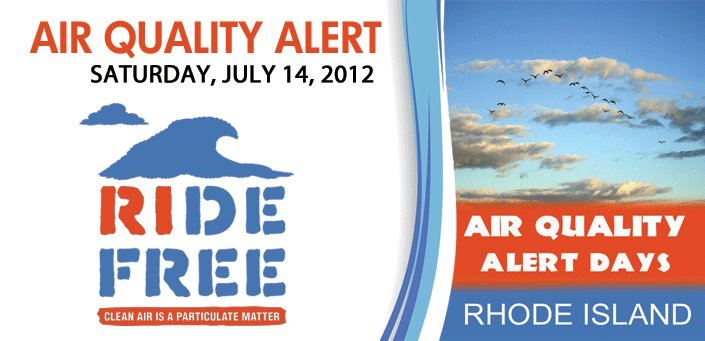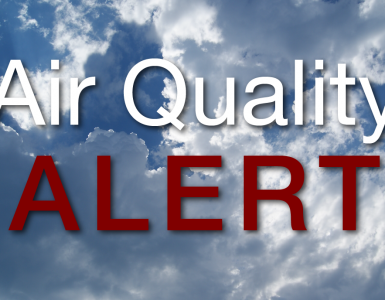
Another Air Quality Alert Day tomorrow:
All regular RIPTA buses and trolleys, but excluding special services, will be free on Saturday, July 14, 2012.
The Rhode Island Department of Environmental Management is predicting that air quality will reach unhealthy levels in Rhode Island, but especially in southern sections again in the afternoon on Thursday. A very hot and very humid air mass with west winds will be present at that time, which will lead to unhealthy air conditions. The poor air quality will be due to elevated ground level ozone concentrations. Ozone is a major component of smog and is formed by the photochemical reaction of pollutants emitted by motor vehicles, industry and other sources in the presence of elevated temperatures and sunlight.
Rhode Island residents can help reduce air pollutant emissions. Limit car travel and the use of small engines, lawn motors and charcoal lighter fuels. Travel by bus or carpool whenever possible, particularly during high ozone periods.
The Department of Health warns that unhealthy levels of ozone can cause throat irritation, coughing, chest pain, shortness of breath, increased susceptibility to respiratory infection and aggravation of asthma and other respiratory ailments. These symptoms are worsened by exercise and heavy activity. The children, elderly and people who have underlying lung diseases, such as asthma, are at particular risk of suffering from these effects. As ozone levels increase, the number of people affected and the severity of the health effects also increase.
To avoid experiencing these effects, limit outdoor exercise and strenuous activity and stay in an air-conditioned environment if possible during the afternoon and early evening hours, when ozone levels are highest. Schedule outdoor exercise and children’s outdoor activities in the morning hours. Individuals who experience respiratory symptoms may wish to consult their doctors.
The unhealthy levels of ozone are expected to last as long as the hot sunny weather is present. The Rhode Island Chapter of the American Lung Association reminds people that “when you can’t breathe nothing else matters.”
Below are some ways that you can help contribute to lower ground level ozone levels and cleaner air:
- Limit driving. Avoid unnecessary car trips. Carpool, walk or ride the bus or a bicycle whenever possible.
- Minimize starts and avoid unnecessary acceleration. Vehicle emissions are highest during starting and acceleration.
- Reduce idling. Avoid congested traffic and lines at drive-through windows.
- Drive your lowest emission vehicle. Use the most fuel-efficient, usually the newest, car you have whenever possible.
- Refuel at stations, which have vapor recovery. Fill your tank at a station which is equipped with a Stage II vapor recovery system. Don’t top off.
- Maintain your vehicle. Get a tune-up at the beginning of each summer.
- Minimize lawn mower emissions. Tune-up your lawn mower and use electric or handpowered equipment if possible.
- Limit use of solvent-based household products. Use water-based or low solvent paints, varnishes, cleaners, and personal care products.
- Limit barbecue emissions. Use an electric starter instead of lighter fluid to start charcoal fires, or use an electric, natural gas, or propane grill.




Kind of interesting that whenever the temp goes 90F or above it’s a free day for RIPTA.
So expect Monday and Tuesday to be air quality alert days too – temps in the 90’s there.
Has Ripta published data showing that free-ride days brings auto drivers out of their cars and onto buses? The cost to Ripta in lost cash revenue on free-ride days must be quite high, unless most people are using non-cash passes
The free ride program is sponsored through a Federal clean air initiative. RIPTA does not lose any money.
Interesting point, thanks. I wonder whether the feds have published any such data, for Providence or for any/all other areas for which the initiative is extended.